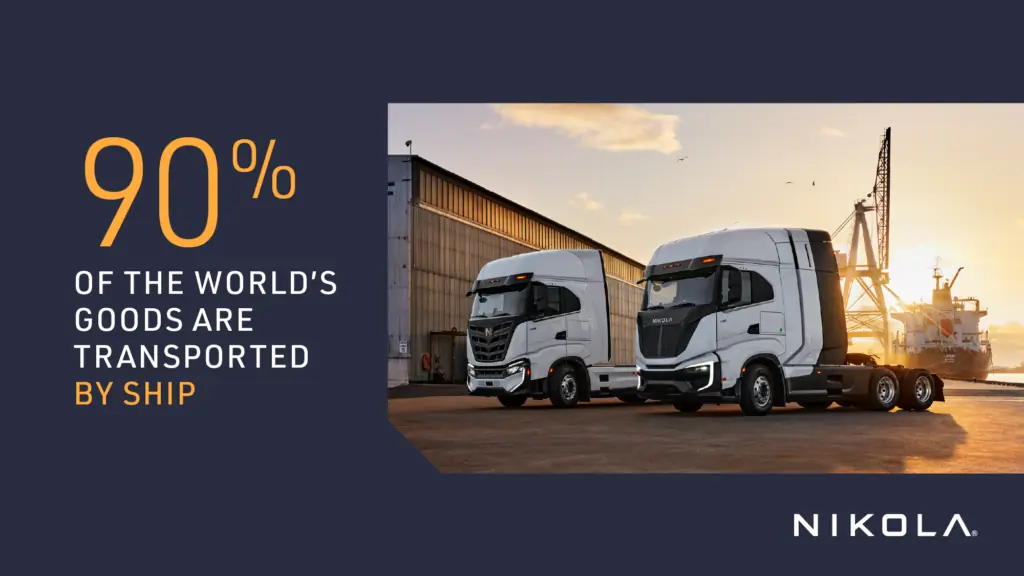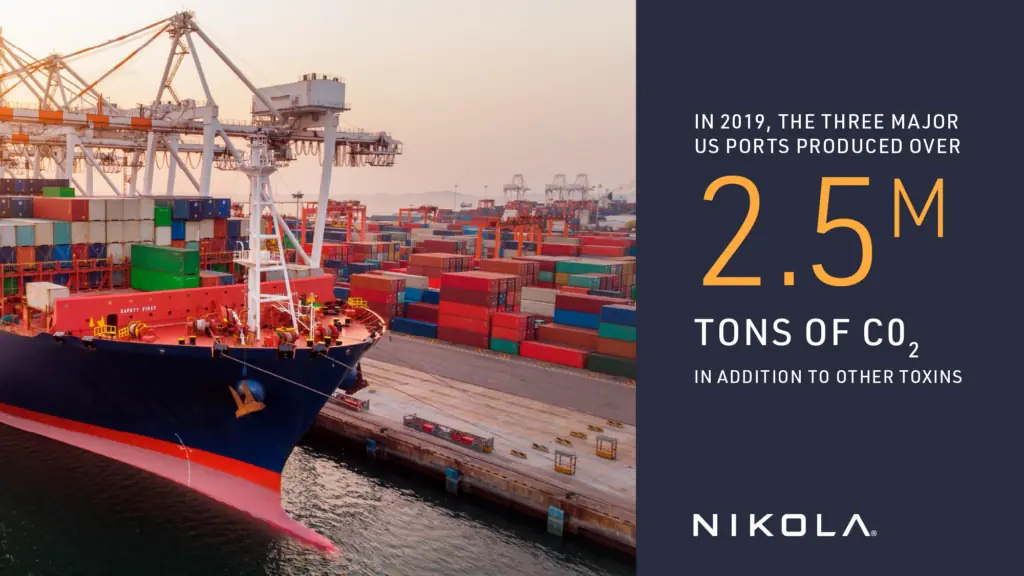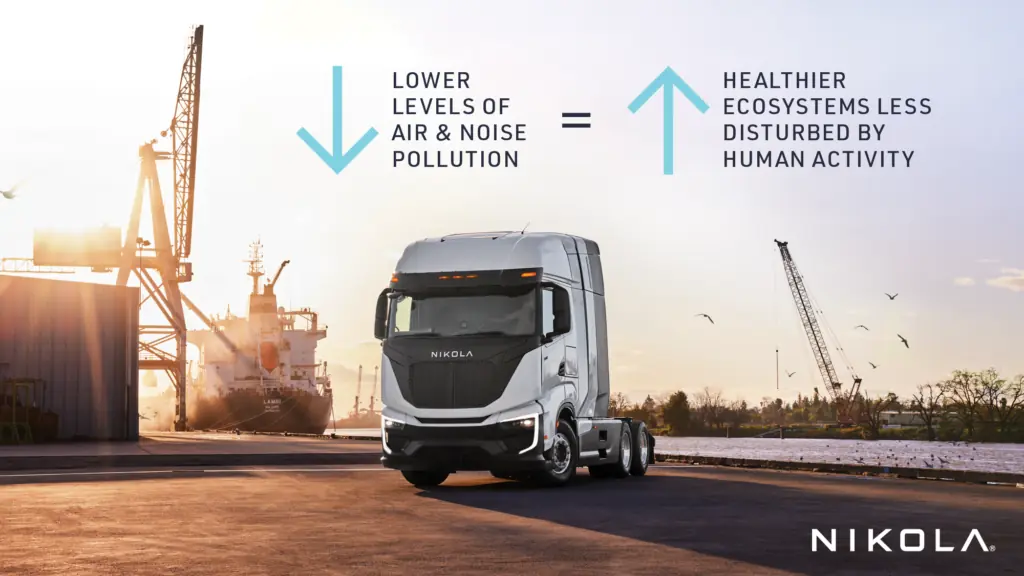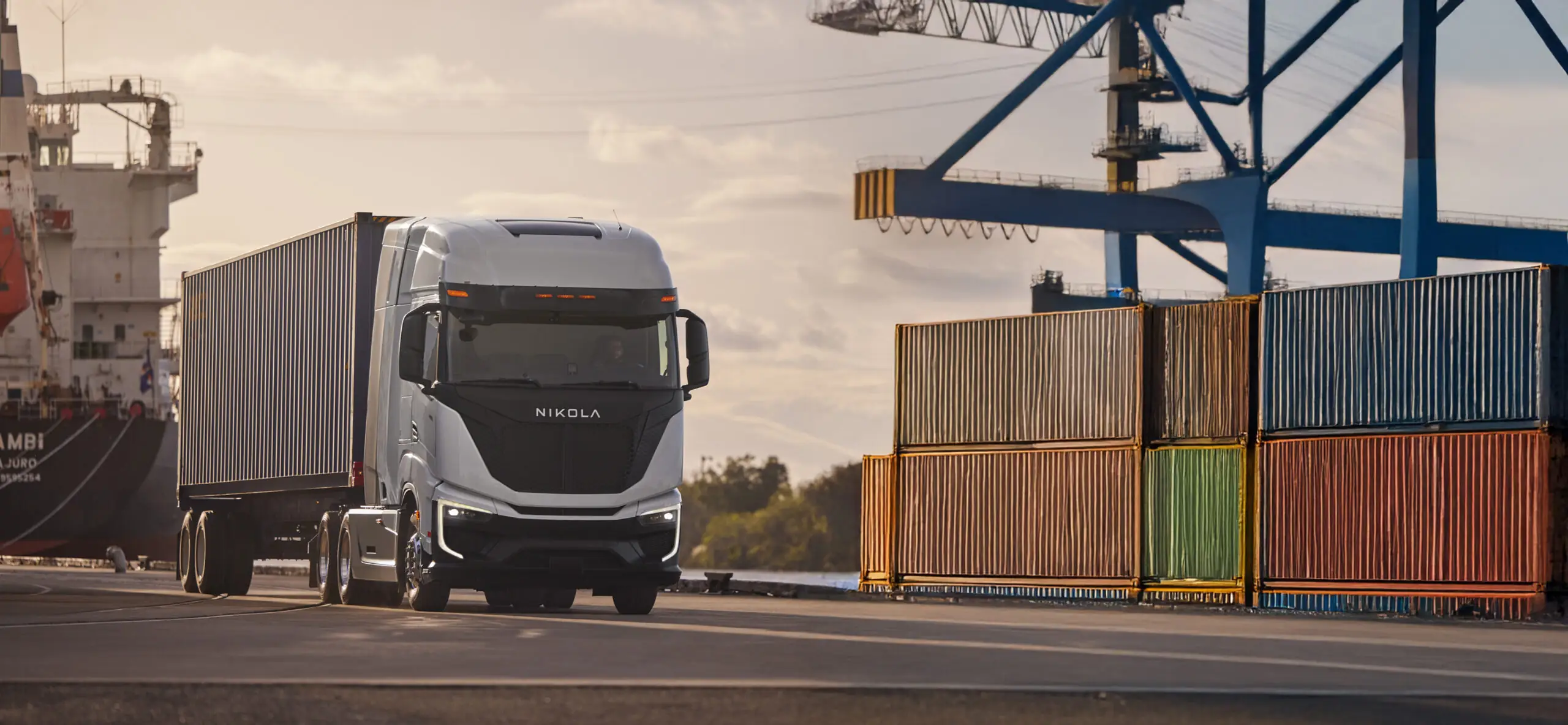Increasing Sustainability at US Ports: The Value of a Zero-Emissions Fleet
The hot topic of climate change is no longer escapable. US ports, and the Class 8 trucks that visit them, are a new focus of discussion where environmentally friendly commerce is concerned. With 90% of the world’s goods transported by ship, ports and the trucks that carry goods from ports to the rest of the country are critical to modern infrastructure[EF1] .

Traditional heavy-duty diesel trucks cause numerous health and environmental issues, but transitioning to zero-emissions fleets presents innovative solutions. By adopting clean technologies like the Nikola battery electric vehicles (BEVs) and the Nikola hydrogen fuel cell electric vehicles (FCEVs), the activity at ports can operate cleaner, smoother, and healthier for all—front-line workers, surrounding neighborhoods, and even the nearby flora and fauna.
Idling Diesel Trucks Create Significant Pollution
In the last several years, ports have suffered major congestion due to shipping and supply chain changes, all made worse by incoming and outgoing trucks awaiting direction, and loading. Diesel trucks idling at ports are a significant source of pollution, both by creating harmful air contaminants and unnecessary noise.
Air pollutants like particulate matter (PM), nitrogen oxides (NOx), sulfur oxides (SOx), carbon monoxide (CO), and volatile organic compounds (VOCs) degrade air quality for truck drivers, port workers, and local residents. Studies have shown that PM and NOx can especially lead to respiratory issues, cardiovascular diseases, and other serious health problems for anyone regularly exposed to these pollutants. Carbon emissions have increased in focus over the last few decades as companies are becoming increasingly aware of the effect of harmful greenhouse gas emission on people and the planet. In 2019, the three major US ports produced over 2.5 million tons of C02 in addition to other toxins[EF2] .

Beyond the issue of air quality, the constant rumble of idling diesel trucks causes significant noise pollution. These unnatural sounds disrupt the natural environment and are shown to negatively affect the mental and physical health of port workers and truck drivers. The persistent background noises of diesel trucks also diminish the quality of life for surrounding communities and their human and animal inhabitants.
By recognizing these challenges as solvable issues, US ports and drayage fleets can collaborate to create healthier and more sustainable working environments.
Zero-Emissions Trucks Help Solve Sustainability Challenges
Zero-emissions vehicles (ZEVs) are designed to solve the sustainability challenges found in US ports throughout the nation. Nikola offers two types of zero-emissions trucks—the battery electric and the hydrogen fuel cell—to help fleets who are looking to be a part of the solution[EF3] .

Clean fleets bring four distinct benefits to US ports, as follows:
- ZEVs Reduce Greenhouse Gas Emissions: BEVs and FCEVs produce zero tailpipe emissions, thus significantly reducing the overall carbon footprint of port operations. By transitioning to ZEVs in the form of trucks, cranes, forklifts, and other necessary mechanical equipment, ports can dramatically cut their greenhouse gas emissions to better align with local, national and global climate goals.
- ZEVs Improve Nearby Air Quality: When PM, NOx, and other toxic chemicals are eliminated from emissions with BEV and FCEV trucks, the air quality immediately shows a noticeable improvement. As a result, port workers, truck drivers, and local residents are less likely to be affected by air pollution and as a result, may enjoy fewer health problems and a better quality of life.
- ZEVs Reduce Noise Pollution: One of the most noticeable benefits of BEVs and FCEVs is their smooth and quiet operation. Unlike diesel trucks, which generate significant noise, battery and hydrogen fuel cell powered trucks operate on a much quieter decibel level. This major reduction in noise pollution greatly enhances the physical and mental health of port employees and truck drivers in their working environment. In addition, ZEVs minimize noise disruptions to nearby communities, benefiting neighboring residents and their overall well-being.
- ZEVs Contribute to Overall Efficiency: BEV and FCEV trucks are designed to be more energy efficient than their diesel counterparts. Both types consume less energy than diesel trucks, not only reducing operational and maintenance costs but also supporting broader sustainability goals by minimizing energy waste.
ZEVs Power Cleaner Air and Healthier Communities
When US ports transition away from diesel to BEV and FCEV trucks, the advantages do not stop at the obvious recipients but expand into the surrounding neighborhoods. Sustainability efforts of commercial operations reduce air and noise pollution for the greater community and help boost other environmental efforts within the whole region. Consider the positive ripple effects in four areas when implementing zero-emissions trucks[EF4] :

- Local Neighborhoods: As air quality improves and noise pollution decreases, the overall quality of life for residents near ports will rise. Cleaner air and quieter environments help to create healthier and more vibrant communities.
- Nearby Businesses: The shift to ZEVs can improve the economy of an area by creating new jobs in vehicle maintenance, infrastructure manager and development, and technology innovation. Additionally, the long-term operational savings from potentially lower fuel and maintenance costs can be reinvested into the workforce, further driving economic growth.
- Regional and Global Development: By reducing emissions and energy consumption during the transition to zero-emissions trucks, ports can set a standard in solving environmental issues. In turn, these ports align with local, regional and national environmental goals, position the US as a leader in global sustainability, and demonstrate that it is not only possible but also beneficial for other industries to follow suit.
- Area Wildlife: Beyond the consideration that ZEVs benefit human health and economics, reducing pollution at ports also helps local wildlife and the earth as a whole. Lower levels of air and noise pollution can lead to healthier ecosystems where coastal wildlife is less disturbed by human activity.
The Path to Sustainability, Safety, and Savings for US Ports
Adopting sustainable practices at US ports is fundamental to the future of the industry. While the environmental and health challenges caused by diesel fleets are significant, there is a solution. By transitioning to the Nikola battery electric or hydrogen fuel cell trucks, ports can reduce their carbon footprint, improve air and sound quality for healthier communities, and potentially achieve long-term operational cost reductions through lower fuel and maintenance costs.
Connect with a Nikola authorized dealer to learn how to lead the charge.
Sources:
- “Delivering Clean Air: Health Benefits of Zero-Emission Trucks.” American Lung Association, https://www.lung.org/getmedia/e1ff935b-a935-4f49-91e5-151f1e643124/zero-emission-truck-report#:~:text=Heavy%2Dduty%20trucks%20deliver%20major,benefits%20across%20the%20United%20States.
- “Battery-Electric Truck and Bus Energy Efficiency Compared to Conventional Diesel Vehicles.” California Air Resources Board, https://ww2.arb.ca.gov/resources/documents/battery-electric-truck-and-bus-energy-efficiency-compared-conventional-diesel#:~:text=The%20results%20show%20that%20the,from%20conventional%20engines%20are%20highest.
- “Estimating Maintenance and Repair Costs for Battery Electric and Fuel Cell Heavy Duty Trucks.” UC Davis eScholarship, https://escholarship.org/content/qt36c08395/qt36c08395_noSplash_589098e470b036b3010eae00f3b7b618.pdf?t=r6zwjb&utm.
- “The Environmental Benefits from Transportation Electrification: Urban Buses.” Dartmouth College, https://www.mansur.host.dartmouth.edu/papers/holland_mansur_muller_yates_buses.pdf.
- “Public Health and Climate Benefits and Trade-Offs of U.S. Vehicle Electrification.” AGU Publications, https://agupubs.onlinelibrary.wiley.com/doi/10.1029/2020GH000275.
